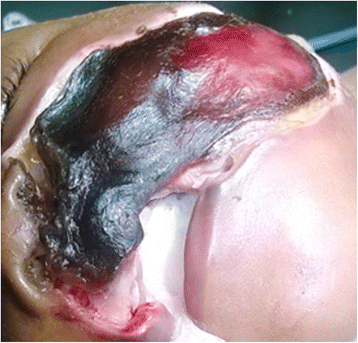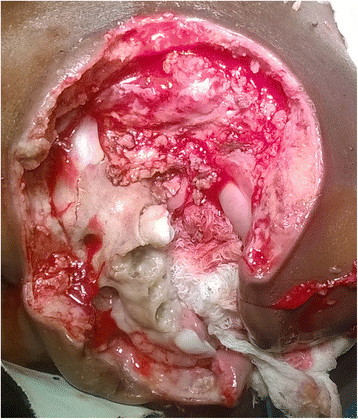Noma as a complication of false teeth (Ebiino) extraction: a case report
- PMID: 28412977
- PMCID: PMC5393018
- DOI: 10.1186/s13256-017-1276-5
Noma as a complication of false teeth (Ebiino) extraction: a case report
Abstract
Background: Ebiino, also known as false tooth extraction, is a traditional practice done mainly in the remote areas of African countries, including Uganda. It involves the extraction of tooth buds in babies with common childhood illnesses such as fever, cough, and diarrhea. It is thought that the tooth buds are responsible for the ailments seen in these infants. The practice is performed by traditional healers using unsterile instruments. The complications associated with this dangerous practice have been mentioned in the literature and include anemia and septicemia, among others. This case report describes a baby with noma, an orofacial gangrenous infection.
Case presentation: A 16-month-old girl from western Uganda belonging to the Banyankole ethnic group was admitted to Mbarara University Teaching Hospital with a 5-day history of a dark lesion on the left cheek. The lesion had started from the left upper gum at the site where a tooth bud had been extracted 1 week prior to admission. The child had experienced occasional cough and fever and also had erupting tooth buds. These tooth buds had been seen as the cause of the cough and fever by the traditional herbalist; hence, they were extracted. An unsterile instrument had been used for the procedure. At the hospital, a local examination showed necrotic tissue involving the left cheek and extending into the left upper gingival area of the girl's mouth. A clinical diagnosis of orofacial gangrene (noma) was then made.
Conclusions: Ebiino, or false tooth extraction, is still practiced in some remote areas of Uganda. Noma has been mentioned as a possible complication of this traditional practice; however, case reports in the literature are scant. Public awareness of the dangers of this practice is therefore still required to prevent this dangerous complication.
Keywords: Case report; Ebiino; False tooth extraction; Noma; Traditional practice.
Figures
Similar articles
-
Prevalence and dental effects of infant oral mutilation or Ebiino among 3-5 year-old children from a rural district in Uganda.BMC Oral Health. 2019 Sep 2;19(1):204. doi: 10.1186/s12903-019-0890-6. BMC Oral Health. 2019. PMID: 31477127 Free PMC article.
-
Agony resulting from cultural practices of canine bud extraction among children under five years in selected slums of Makindye: a cross sectional study.BMC Oral Health. 2018 Aug 7;18(1):133. doi: 10.1186/s12903-018-0599-y. BMC Oral Health. 2018. PMID: 30086761 Free PMC article.
-
Missing primary teeth due to tooth bud extraction in a remote village in Tanzania.Int J Paediatr Dent. 1992 Apr;2(1):31-4. doi: 10.1111/j.1365-263x.1992.tb00005.x. Int J Paediatr Dent. 1992. PMID: 1525129
-
[Noma].Rev Stomatol Chir Maxillofac Chir Orale. 2015 Sep;116(4):261-79. doi: 10.1016/j.revsto.2015.06.009. Epub 2015 Jul 30. Rev Stomatol Chir Maxillofac Chir Orale. 2015. PMID: 26235765 Review. French.
-
Noma: Overview of a Neglected Disease and Human Rights Violation.Am J Trop Med Hyg. 2017 Feb 8;96(2):268-274. doi: 10.4269/ajtmh.16-0718. Epub 2017 Jan 16. Am J Trop Med Hyg. 2017. PMID: 28093536 Free PMC article. Review.
Cited by
-
A retrospective clinical, multi-center cross-sectional study to assess the severity and sequela of Noma/Cancrum oris in Ethiopia.PLoS Negl Trop Dis. 2022 Sep 13;16(9):e0010372. doi: 10.1371/journal.pntd.0010372. eCollection 2022 Sep. PLoS Negl Trop Dis. 2022. PMID: 36099293 Free PMC article. Review.
-
Prevalence and dental effects of infant oral mutilation or Ebiino among 3-5 year-old children from a rural district in Uganda.BMC Oral Health. 2019 Sep 2;19(1):204. doi: 10.1186/s12903-019-0890-6. BMC Oral Health. 2019. PMID: 31477127 Free PMC article.
-
Noma in an 18 months Toddler: A Rare Case Report with Review of Literature.J Maxillofac Oral Surg. 2024 Apr;23(2):320-327. doi: 10.1007/s12663-023-02046-8. Epub 2023 Nov 15. J Maxillofac Oral Surg. 2024. PMID: 38601243 Free PMC article.
-
Peripheral extremity gangrene following infant oral mutilation (Ebinyo): a case report from Northern Uganda.Afr Health Sci. 2025 Jun;25(2):79-84. doi: 10.4314/ahs.v25i2.11. Afr Health Sci. 2025. PMID: 40837642 Free PMC article.
-
Systematic scoping review of the noma evidence landscape: current knowledge and gaps.BMJ Glob Health. 2025 Jul 31;10(7):e018023. doi: 10.1136/bmjgh-2024-018023. BMJ Glob Health. 2025. PMID: 40744672 Free PMC article.
References
-
- Auluck A, Pai KM. Noma: life cycle of a devastating sore – case report and literature review. J Can Dent Assoc. 2005;71(10):757. - PubMed
Publication types
MeSH terms
Substances
Supplementary concepts
LinkOut - more resources
Full Text Sources
Other Literature Sources
Medical



